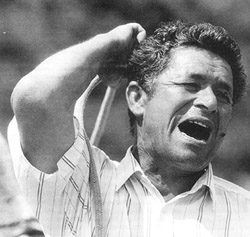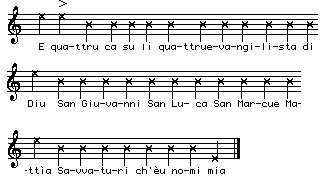recital of prayers, the output of the folk singers or the contastorie (storytellers), exclamations or incitements to work, enumerative chants, lullabies). The most emblematic record of such a recital within the scope of this research is represented by the Larata of San Cataldo.
In this example the rhythmic beat is independent of the quantity or the accentuation of the syllables. In fact it is closely connected to the modification in the intonation that provokes a periodicity of melodic curves in the recital characterised by an incipit on the sharpest note, followed by an insistence upon a "corda di recita" and a falling "final cadenza". The rhythmical beat can thus be related to a temporal measure (i.e. the recited tempo or silence) that, in its communicative-structural dimension, can only be understood dynamically. In such a way we can single out a sort of metre made up by the repetition of such tones or by their opposition. |

